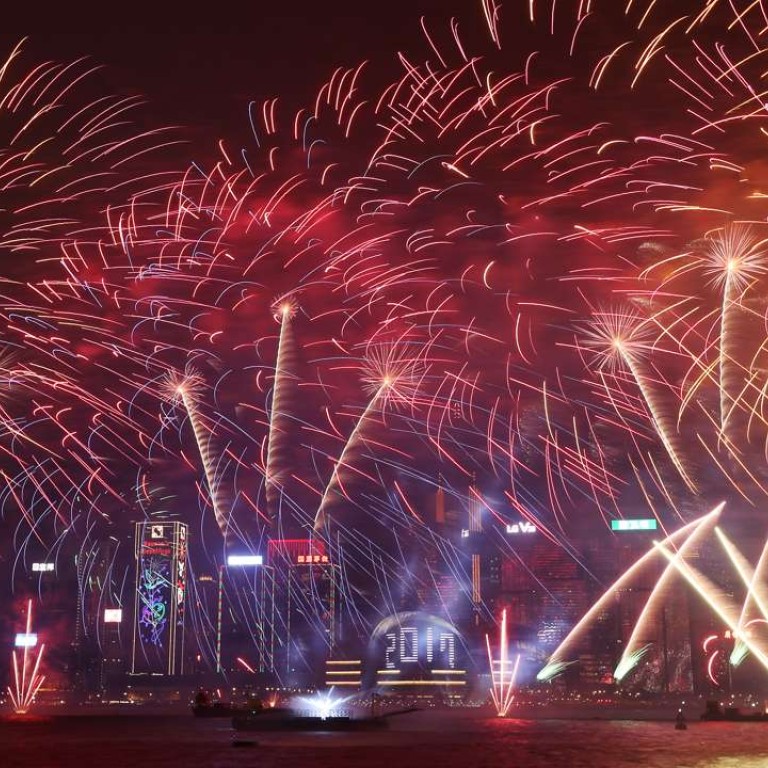
24,000 fireworks shells to explode over Victoria Harbour in epic Lunar New Year display
The 23-minute extravaganza will cost about HK$8 million, paid for by sponsor Unique Timepieces by Halewinner
Almost 24,000 pyrotechnic shells will be fired from three barges in Hong Kong’s Victoria Harbour in an epic Lunar New Year fireworks celebration to mark the Year of the Rooster in 2017, it has been announced.
The 23-minute display will cost about HK$8 million, paid for by sponsor Unique Timepieces by Halewinner, according to the Home Affairs Bureau.
On Monday it was announced that the eight-part show will also feature the number ‘20’ in blazing fireworks glory to mark the 20th anniversary of Hong Kong’s establishment as a Special Administrative Region.
The sponsors said they hoped to “bring a joyful night to citizens and tourists of Hong Kong”.
Unique Timepieces by Halewinner is chaired by Karson Choi, son of billionaire toymaker Francis Choi, and owned by the Halewinner Watches Group.
Visitors are invited to watch the display in Tsim Sha Tsui, Mid-Levels, Central, Wan Chai, Causeway Bay and the Hung Hom Bypass.
Despite the hotly anticipated event, the Hong Kong government has been accused of wasting an extra HK$2 million on the New Year’s Eve fireworks, following recent public debates about the widening wealth gap in the city.
The harbourfront display on December 31 cost the government HK$15 million in 2016, an increase from HK$13 million in 2015 and 2014. The display, set to a remix of traditional folk tune Auld Lang Syne, was lengthened from eight to ten minutes as a result of the expanded budget.
More than 300,000 people reportedly gathered to watch the show on both sides of Victoria Harbour, with most congregating in Central and Tsim Sha Tsui.
Legislative Council member Claudia Mo Man-ching said the increased spending was not justified.
She said: “It does sound unnecessarily extravagant to me and not justifiable given the wealth divide.
“I’m not sure about the actual visual benefits. Why is that necessary given we’ve got smog from the mainland that night?”
According to Oxfam Hong Kong’s Poverty Report 2011-2015, the wealth gap last year in the city had grown, with the number of low-income households increasing by 1.7 per cent from 454,100 in 2014 to 461,900.
This meant some of Hong Kong’s richest now earn about 29 times more than the poorest.
A spokeswoman for the Hong Kong Tourism Board defended the extra budget and said the event had generated tremendous publicity for Hong Kong.
She said: “The board arranged a satellite feed to broadcast the countdown celebrations live for global TV stations. The result was encouraging.”
She added that major news agencies worldwide covered the event and generated “enormous international exposure for Hong Kong”.

Professor Brian King, associate dean at Polytechnic University’s school of hotel and tourism management, said the extra spending was acceptable if the display helped Hong Kong to maintain its profile internationally.
“Hong Kong needs to be in the spotlight for the New Year celebrations,” he said, adding: “In broader terms, it will go beyond just tourism. It is not a waste of money, it is more about where the money is coming from.”
The widely praised fireworks in Sydney, Australia, for example, cost taxpayers just under A$1 million (HK$5.6 million) in 2015. The entire display over Sydney Harbour cost an estimated A$7 million (HK$39.6 million).
Other major fireworks in Hong Kong planned for this calendar year include July 1, also to celebrate the 20th anniversary of the Special Administrative Region, and October 1 for National Day, as well as the next New Year’s Eve display on December 31.
Prospective sponsors for the July 1 fireworks are invited to apply to the government by February 6.

